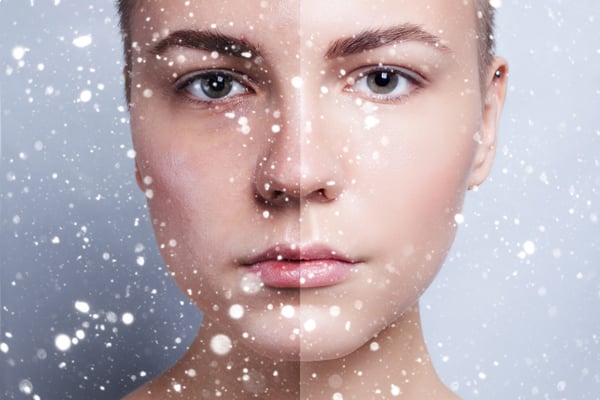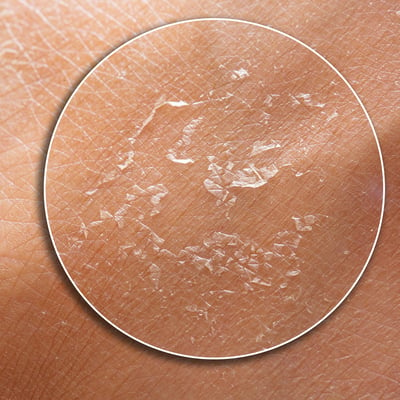
Love it or hate it, cold winter weather delivers at least some positives each year: Fewer annoying insects biting your ankles, a reprieve from the pollen that flares seasonal allergies, and a welcome break from all those breakouts.
Except, when it’s not. Instead of calming down, your face can actually flare up in wintertime with breakouts that feel more stubborn than ever.
But isn’t cooler weather supposed to help acne? After all, people sweat less in cooler weather, and they are less likely to use greasy sun blocks—shouldn’t that mean less stuff to clog your pores?
It’s a frustrating contradiction: For many people, winter is actually the prime breakout season. The culprit for these dry weather breakouts isn’t just “dryness” or “hormones” but instead a perfect storm of environmental shifts, skin care missteps, and sneaky habits that disrupt your skin’s balance.
What the science says about winter acne
Are you one of the unlucky ones who feels like their skin is rebelling every winter? It turns out that cold weather does more than just dry the skin; it alters the entire ecosystem of our largest organ.
First, a quick skin primer: The outermost layer of your skin is known as the stratum corneum, and it performs some key functions, including preventing water loss, protecting you from UV radiation, and shielding the body against harmful substances. In the winter, however, that layer becomes thinner, which means it’s less effective at keeping valuable moisture in,and keeping out the bacteria that cause acne.
Here’s a closer look at what’s happening beneath the surface:
- Reduced ceramide levels: Ceramides are lipids that help maintain the skin barrier. The cold reduces ceramide production, making the skin more prone to irritation and inflammation.
- Microbiome disruption: Winter causes the skin’s natural bacterial balance to shift, leading to an overgrowth of Cutibacterium acnes. While these bacteria normally play a role in maintaining healthy skin, an excess can become what The Open Dermatology Journal calls “an opportunistic pathogen,” causing winter acne.
- Increased water loss: The dry air that causes itchy, irritated skin also triggers the body to compensate with additional oil production. Unfortunately, that extra oil can clog pores and cause acne.
- Inflammation spike: The damage to your skin’s barrier (exacerbated by dehydration) can all lead to a low-grade inflammation, which can make acne even worse.
So, yes, winter skin is certainly dry, but it’s also compromised. And when that important skin barrier is weakened, it’s more reactive, more sensitive, and more likely to break out. That’s why the usual “just moisturize more” advice for acne in winter sometimes isn’t very effective.
Winter acne causes and how to combat them
Of course, dry air is only one part of the problem. Sometimes, your skin care habits can also unintentionally make things worse. See if any of these common culprits apply to your winter skin care routine and learn what to do instead:
1. Too heavy on the heavy moisturizers
While it’s common to think rich creams will “seal in” all that skin hydration, many contain petrolatum, mineral oil, and shea butter, which can all trap dead cells, sweat, and sebum (an oily substance produced by the sebaceous glands) beneath the surface. These products can then create a breeding ground for bacteria and clogged pores and overwhelm your skin’s natural balance.
Instead, try this: Start with a humectant serum – think glycerin, hyaluronic acid, or polyglutamic acid – to draw water into the skin. Then seal it in with a lightweight moisturizer that contains ceramides, squalane, or panthenol. Remember: Less is more.
2. Clogged pores from winter wear
Scarves, hats, and face masks are cozy, but the constant friction and rubbing can irritate the skin and trigger “acne mechanica,” a form of breakout caused by pressure and heat. Even worse, these accessories also trap oil, sweat, and bacteria.
Instead, try this: Choose breathable, natural fabrics when possible, and wash winter gear regularly. Also avoid tight-fitting hats and scarves that press against breakout-prone areas.
3. Skipped exfoliation and routine disruption
The dry skin caused by winter may make you a little more cautious, and you might find yourself skipping your normal exfoliation to avoid irritation. Keep in mind, however, that dead skin cells build up more quickly in dry air, and without regular exfoliation, your pores will get blocked.
Instead, try this: Stick to gentle exfoliants like lactic acid, mandelic acid, or enzyme-based formulas a couple times a week. Gel or cream cleansers with a low pH are ideal.
3. Dehydration-induced oil production
When your skin loses moisture, it compensates by producing more oil. But this oiliness can clog pores and trigger breakouts, especially if your barrier is already compromised. While drinking more water is always a good idea, you’ll need hydration directly on your skin as well.
Instead, try this: Invest in a high-quality humidifier, and try hydrating serums with ingredients like panthenol, ceramides, and squalane to support barrier repair.
Bonus tip: UV rays don’t take a winter break, so keep using a broad-spectrum SPF daily, especially if you’re using exfoliants or acne treatments that increase sensitivity.
Taking the power back from winter acne
While these simple tweaks should help keep seasonal acne flare-ups under control, be sure to check in with a dermatologist if your acne worsens or doesn’t respond to these routine changes. You might be dealing with fungal acne, rosacea, or another condition that mimics breakouts.
Winter skin care isn’t about fighting your skin but about working with it. With the right tweaks and a better understanding of winter triggers, you can keep your complexion calm, clear, and resilient all season long.





